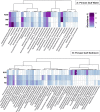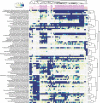Distinct microbial community along the chronic oil pollution continuum of the Persian Gulf converge with oil spill accidents
- PMID: 34059729
- PMCID: PMC8166890
- DOI: 10.1038/s41598-021-90735-0
Distinct microbial community along the chronic oil pollution continuum of the Persian Gulf converge with oil spill accidents
Abstract
The Persian Gulf, hosting ca. 48% of the world's oil reserves, has been chronically exposed to natural oil seepage. Oil spill studies show a shift in microbial community composition in response to oil pollution; however, the influence of chronic oil exposure on the microbial community remains unknown. We performed genome-resolved comparative analyses of the water and sediment samples along Persian Gulf's pollution continuum (Strait of Hormuz, Asalouyeh, and Khark Island). Continuous exposure to trace amounts of pollution primed the intrinsic and rare marine oil-degrading microbes such as Oceanospirillales, Flavobacteriales, Alteromonadales, and Rhodobacterales to bloom in response to oil pollution in Asalouyeh and Khark samples. Comparative analysis of the Persian Gulf samples with 106 oil-polluted marine samples reveals that the hydrocarbon type, exposure time, and sediment depth are the main determinants of microbial response to pollution. High aliphatic content of the pollution enriched for Oceanospirillales, Alteromonadales, and Pseudomonadales whereas, Alteromonadales, Cellvibrionales, Flavobacteriales, and Rhodobacterales dominate polyaromatic polluted samples. In chronic exposure and oil spill events, the community composition converges towards higher dominance of oil-degrading constituents while promoting the division of labor for successful bioremediation.
Conflict of interest statement
The authors declare no competing interests.
Figures







References
-
- Joydas TV, Qurban MA, Borja A, Krishnakumar PK, Al-Suwailem A. Macrobenthic community structure in the Northwestern Arabian Gulf, twelve years after the 1991 oil spill. Front. Mar. Sci. 2017;4:248. doi: 10.3389/fmars.2017.00248. - DOI
-
- Pous S, Lazure P, Carton X. A model of the general circulation in the Persian Gulf and in the Strait of Hormuz: Intraseasonal to interannual variability. Cont. Shelf Res. 2015;94:55–70. doi: 10.1016/j.csr.2014.12.008. - DOI
Publication types
LinkOut - more resources
Full Text Sources

